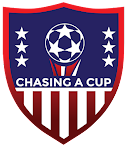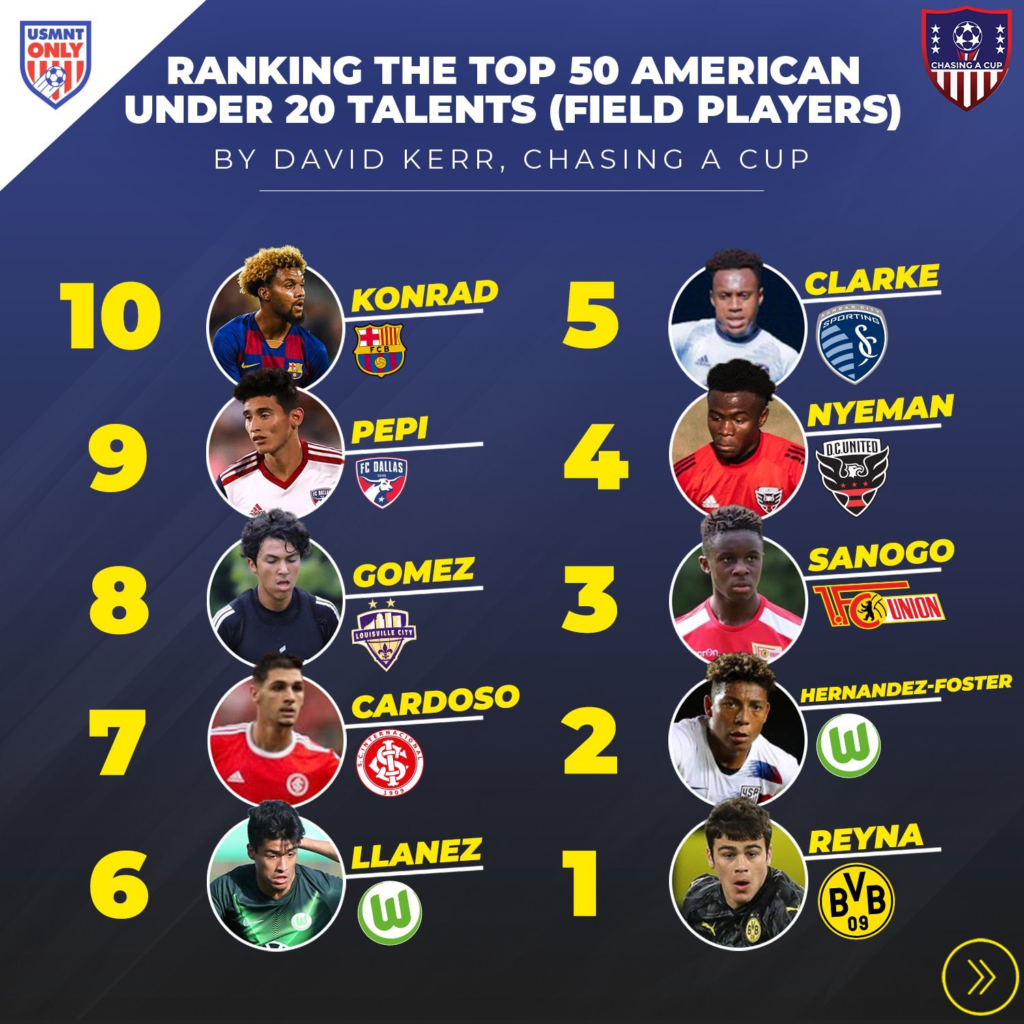

USMNT
Are You Experienced?
Published
2 years agoon
Following the first six games of the Ocho, a media narrative has tried to gain traction that excuses the inconsistent performances on the age of the players. There is no doubt most of the players are young. But are they so much more inexperienced than prior teams?
You might ask, well, if their average age is younger than past teams, how could they not be less experienced professionally? It is a good question, and the answer is that the development of players in the USA has radically changed. In the past, kids went to college at 18 and stayed amateur, playing the unique NCAA game on a limited schedule, until they were drafted by MLS teams or moved abroad at 21-22. So, the starting Defensive Midfielder on the 2002 World Cup team, Pablo Mastroeni, could be 25 and thus three years older than Tyler Adams is now. But Adams has been a pro since 16, with 6 years of experience. Mastroeni went to North Carolina State for four seasons and didn’t turn pro until he was 22.
If you look at past rosters, there were some older players that had more experience even with the delayed start. But the difference isn’t that great. Here is the lineup against Mexico in the 2002 World Cup versus the lineup against Costa Rica last month:
|
2002 |
age |
years pro |
Years Top |
|
Berhalter |
28 |
8 |
0 |
|
Sanneh |
30 |
6 |
3 |
|
Pope |
28 |
6 |
0 |
|
O’Brien |
24 |
4 |
4 |
|
Mastroeni |
25 |
4 |
0 |
|
Reyna |
28 |
8 |
8 |
|
Wolff |
25 |
4 |
0 |
|
Donovan |
20 |
3.0 |
0 |
|
McBride |
29 |
8 |
0 |
|
Lewis |
28 |
6 |
1 |
|
Average |
26.5 |
5.7 |
1.6 |
|
2021 |
age |
years pro |
Years Top |
|
Dest |
20 |
2 |
2 |
|
Miles |
24 |
4 |
0 |
|
Richards |
21 |
1 |
1 |
|
Jedi |
23 |
4 |
1 |
|
Wes |
22 |
4 |
4 |
|
Adams |
22 |
6 |
2 |
|
Musah |
18 |
1 |
1 |
|
Aaronson |
20 |
2 |
1 |
|
Pepi |
18 |
2 |
0 |
|
Weah |
21 |
3 |
3 |
|
Average |
20.9 |
2.9 |
1.5 |
The average ages are starkly different. The 2021 team is, on average, almost 5 years younger. But the 2021 team is only a little less than 3 years less experienced. A number that is being reduced every day as the current players play.
The final column for both teams is the average seasons playing in a Top 5 league. As you can see, the “inexperienced” team of “kids” has equivalent time at the highest level. This is another consequence of the change in development path. NCAA soccer is just not a good development environment for players looking to turn pro. So, Americans coming out of college usually had to start their careers in second divisions or minor leagues. If they started in MLS, very few were even allowed to be sold to Europe. So, by the time a player settled, learned the game, and got good enough to get the interest of an EPL team, for example, they might be 24 like Clint Dempsey or 28 like Brian McBride.
The team against Costa Rica was missing several first-choice players. If we add them in, then the “inexperienced” team is more experienced:
|
2021 |
age |
years pro |
Years Top |
|
Dest |
20 |
2 |
2 |
|
Miles |
24 |
4 |
0 |
|
Brooks |
28 |
9 |
9 |
|
Jedi |
23 |
4 |
1 |
|
Wes |
22 |
4 |
4 |
|
Adams |
22 |
6 |
2 |
|
Musah |
18 |
1 |
1 |
|
Pulisic |
23 |
5 |
5 |
|
Sargent |
21 |
3 |
3 |
|
Reyna |
18 |
1 |
1 |
| Average |
21.9 |
3.9 |
2.8 |
The two 18-year-olds still bring the Years Pro number down a bit. But you can see that experience at the highest level of the game is almost double even as the average age is still 4+ years younger.
So, while the current team is young, they are not wildly inexperienced by historical standards.
Panama…
It seemed no performance was explained away as the vicissitudes of a “young and inexperienced” team than the loss in Panama. It was a historically bad result, very few games have been lost over the last two decades against Central American teams not named Costa Rica. But was it due to the team being young? Here is the lineup that started the game:
|
Moore |
25 |
4 |
0.5 |
|
McKenzie |
22 |
5 |
0 |
|
Zimmerman |
28 |
8 |
0 |
|
Bello |
19 |
4 |
0 |
|
Musah |
18 |
1 |
1 |
|
Acosta |
26 |
8 |
0 |
|
Lletget |
29 |
6 |
0 |
|
Arriola |
26 |
9 |
0 |
|
Zardes |
30 |
8 |
0 |
|
Weah |
21 |
3 |
3 |
| Average |
24.4 |
5.6 |
0.45 |
This lineup is the oldest we have fielded so far! If you take Musah out, who is the only first choice player in the eleven, then you get a team that averages over 25 years old. What stands out is this older group has almost no experience at a level above MLS. The meager Top 5 experience was negligible with Weah pretty much the only player with more than a year at that level followed by the youngest player, Musah. Shaq Moore had a cup of coffee a few years back in La Liga and then that is it.
If you, again, take Weah and Musah out (two new generation players), you have a lineup with the age profile of the 2002 team, with the same professional experience, but none of the top league experience. This is the Lost Generation affecting qualifying again. Dropping an important point or more, in a historically bad result. It has been an emphasis of Berhalter to try and find players in the Lost Generation and force them into the team. But when they were given a chance, together, in this game they came up short. Just like they always have.
Former players will say that Top 5 experience or Champions League experience is no substitute for “Concacaf” experience. I was a fan of all of them, but let’s face it, much of the previous USMNT players that say such cliches never played in the Champions League. Certainly, never played for Champions League contenders like Barcelona or Chelsea. If we look at the data above, age doesn’t seem to be an issue. But experience in the top leagues in the world does seem to be.
Going forward we need to change how we think of the words “young” and “experienced”. It is very plausible that 22-year-old Pulisic has far more experience than 30-year-old Zardes. That experience at the top of the world soccer pyramid trumps age. That the coach that played so many older, but really less experienced, players together made a major miscalculation.
You may like
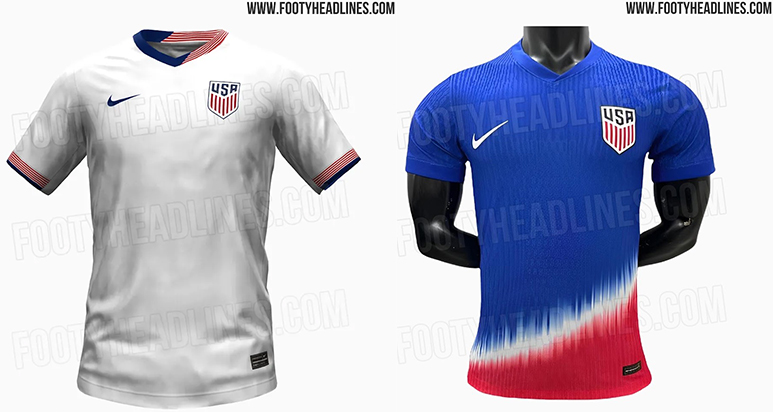
Thomas Deschaine (@uskeeper on X and us_keeper on Instagram)
US Soccer kit releases are something fans get excited about and lately have resulted in disappointment. US Soccer’s recent schedule for kits release during the cycle has seen them releasing another road and or third kits in Gold Cup years and home and away pairs in the even years.
US Soccer is expected to release the 2024 Copa America kits for the USMNT in the coming weeks headed into the Nations League Finals. Last Thursday evening Footy Headlines, who has had a good track record of leaking USMNT kits in the past, provided the below pictures of the home and away USMNT kits. These kits haven’t officially been announced by Nike or US Soccer, but the anticipated announcement is expected in the coming weeks headed into the Nations League Final.

Photo from Footheadlies.com – February 29, 2024
Fake Leaked USMNT Kits
The below USMNT kits were leaked over the last decade, but none of them came to fruition, it’s fun to look at what could have been for the USMNT.
2014 World Cup Kits
These leaked kits headed into the 2014 FIFA World Cup were where loved by many USMNT fans due to the sash and the use of the Centennial Crest, but unfortunately, these kits were fakes and never released.
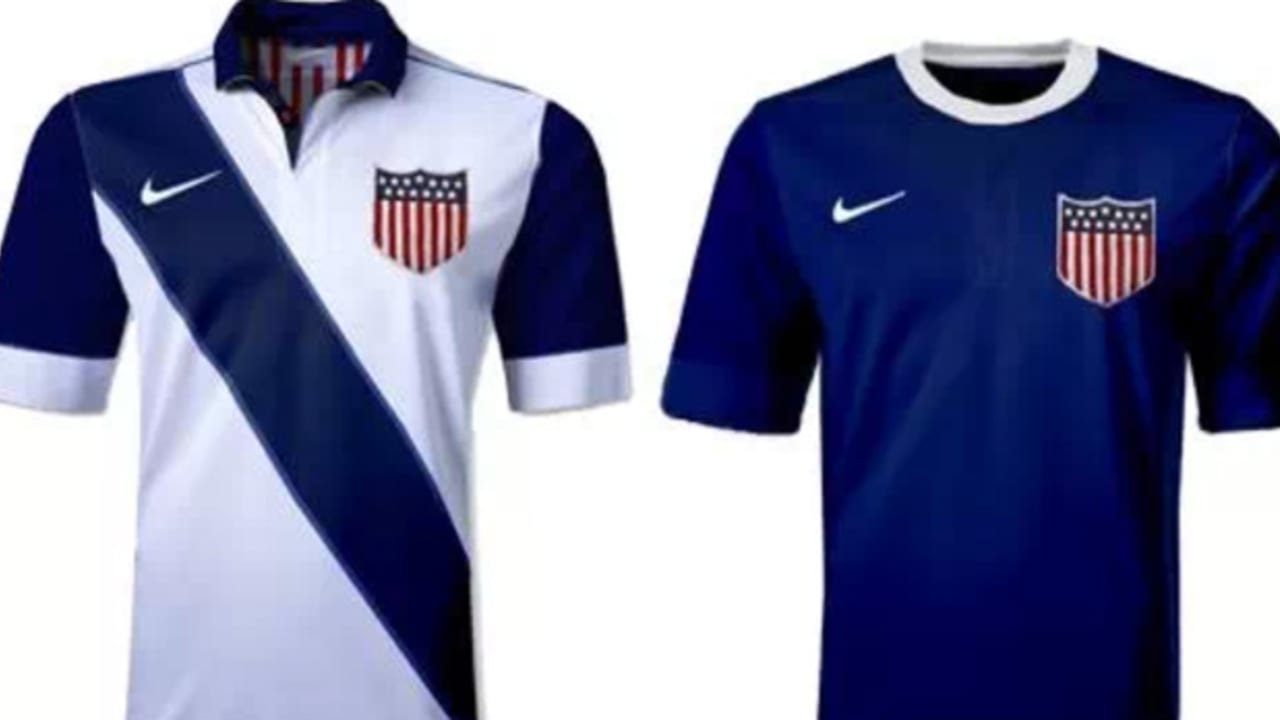
Photo from SportsLogos.Net – September 13, 2013
2015 Alternative Kit & 2016 Copa America
Generally, US Soccer releases an alternate kit in the years that the Gold Cup is played. This leak kit was reported back in 2015 by NBCSports and then again by MLS Soccer when it was suggested it could be used during the Copa América Centenario.
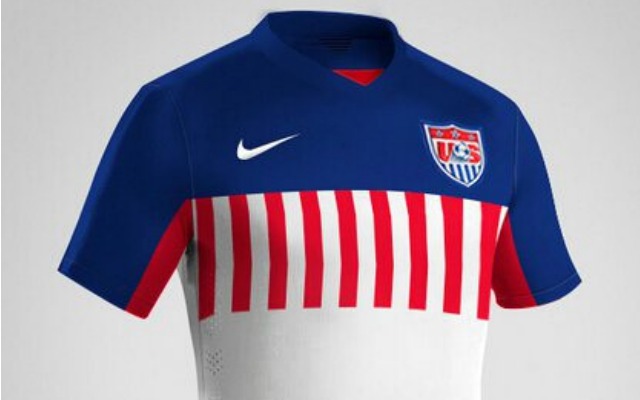
Photo from NBCSports – April 2, 2015
2022 World Cup Kits
I would have much preferred for the USMNT to have worn these kits at the 2022 FIFA World Cup when they ended up, but alas it was another leaked kit that never was.
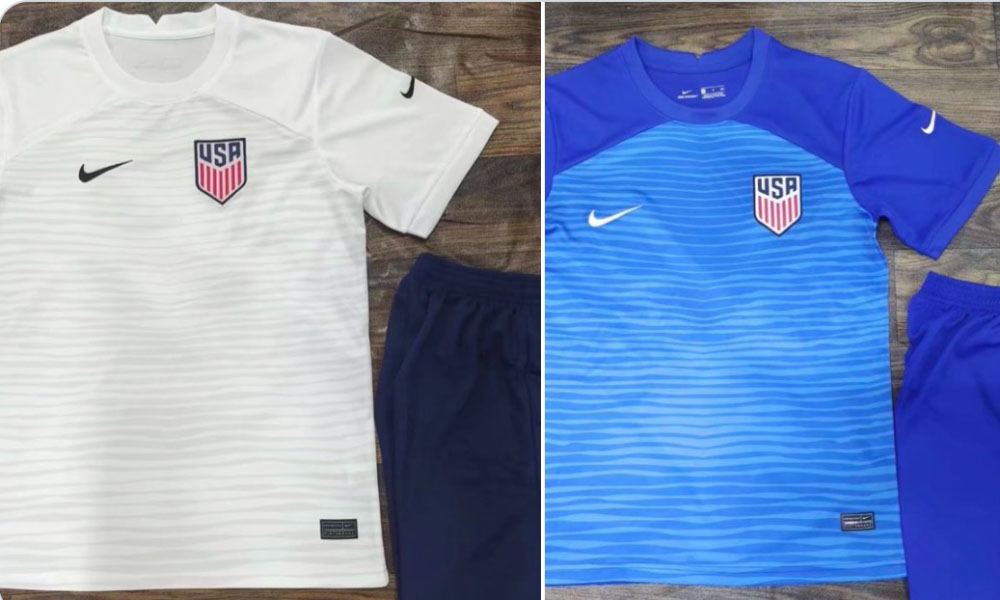
Photo from proscoccerwire.com – May 6, 2022
2024 Copa America Kit
This rumored kit for the USMNT was based on similar kits worn by the USMNT at the 1924 Olympics and the 1930 World Cup.
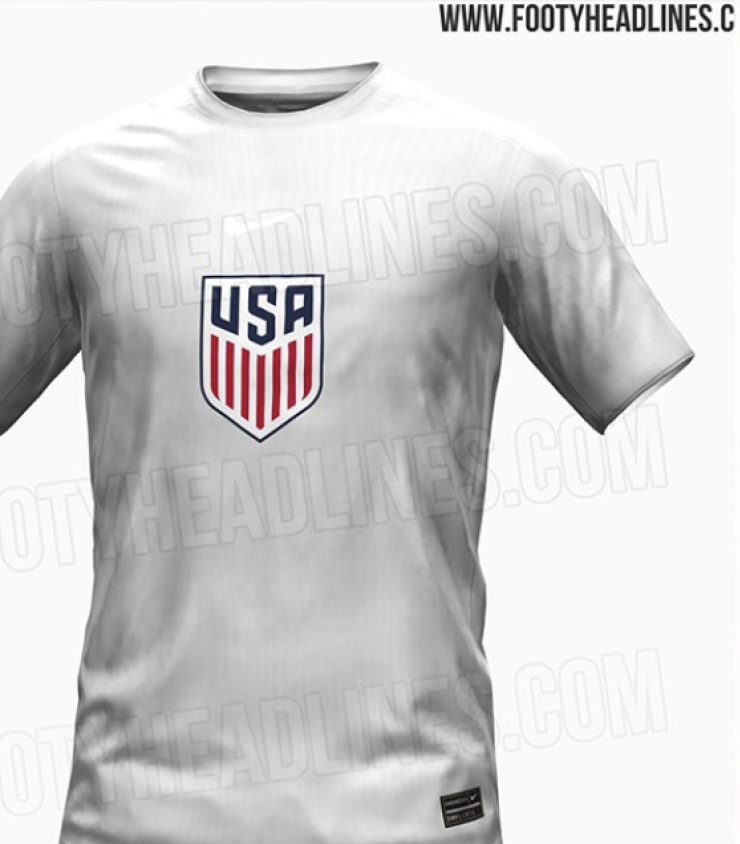
Photo from the18.com via Footieheadlines.com – September 14, 2023
History of US Soccer Crest and USMNT kits
Over ten years ago I began my research of USMNT soccer data in search of a single source site, which I quickly found didn’t exist. Through my research, I started to comply with old USMNT kits and crests from the past. As I acquired more and more kits worn by the USMNT and was able to start to fill in the gaps between them I decided to digitally recreate these kits and share them with the USMNT fans.
Here’s a look at what I was able to find while it seems like a lot I am sure there are many more kits I missed and if so I would love to know which ones so I could create and update what I have already.
History of US Soccer Crests
Here’s the history of the US Soccer crests. I had to recreate several of these crests based on old pictures I found throughout my research since there were no digital images available.
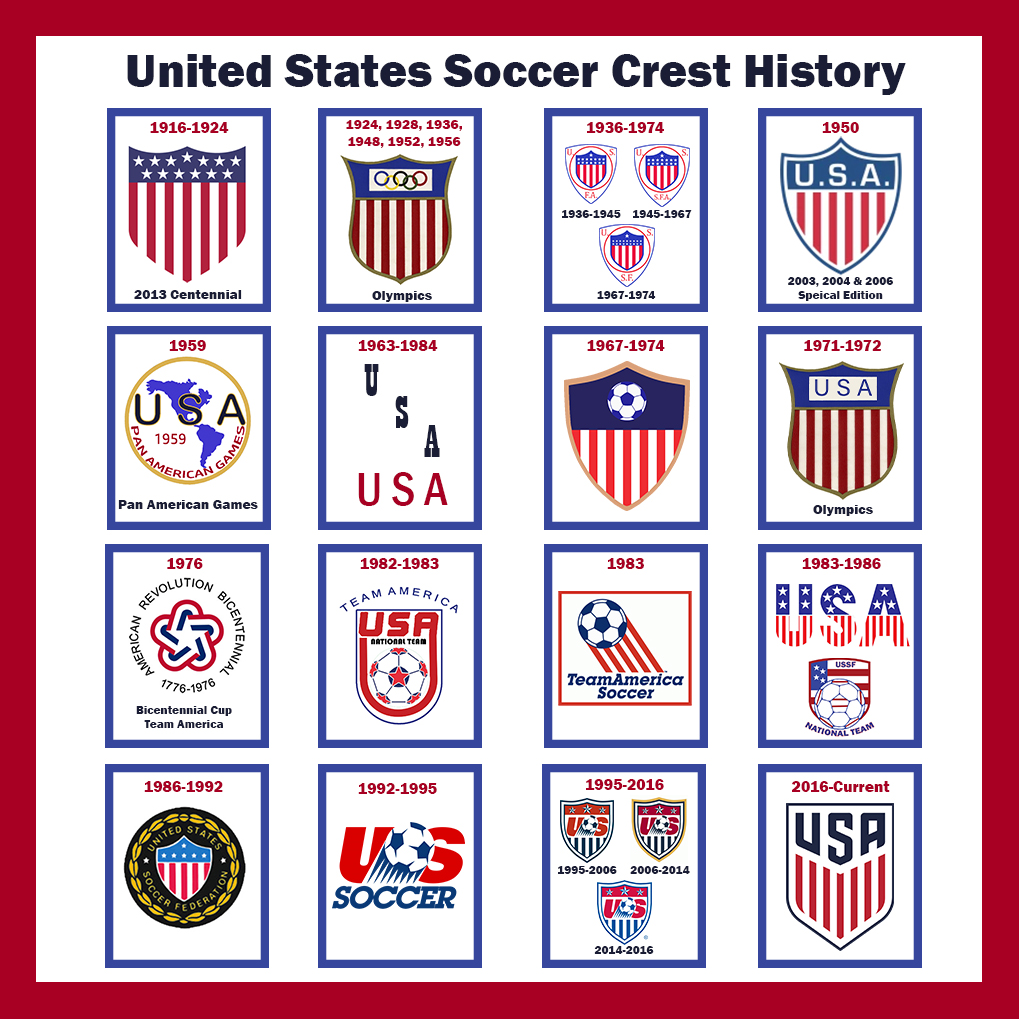
USMNT Kits – 1916-1973
These were the first kits worn by the USMNT which weren’t sponsored. There are variations of these kits worn by the USMNT which comprised of variations of crests and styles, likely due to available funds during this time. My favorite kits in the group are the ones with the sashes from the 1928 and 1936 Olympics and the 1959 Pan American Games.
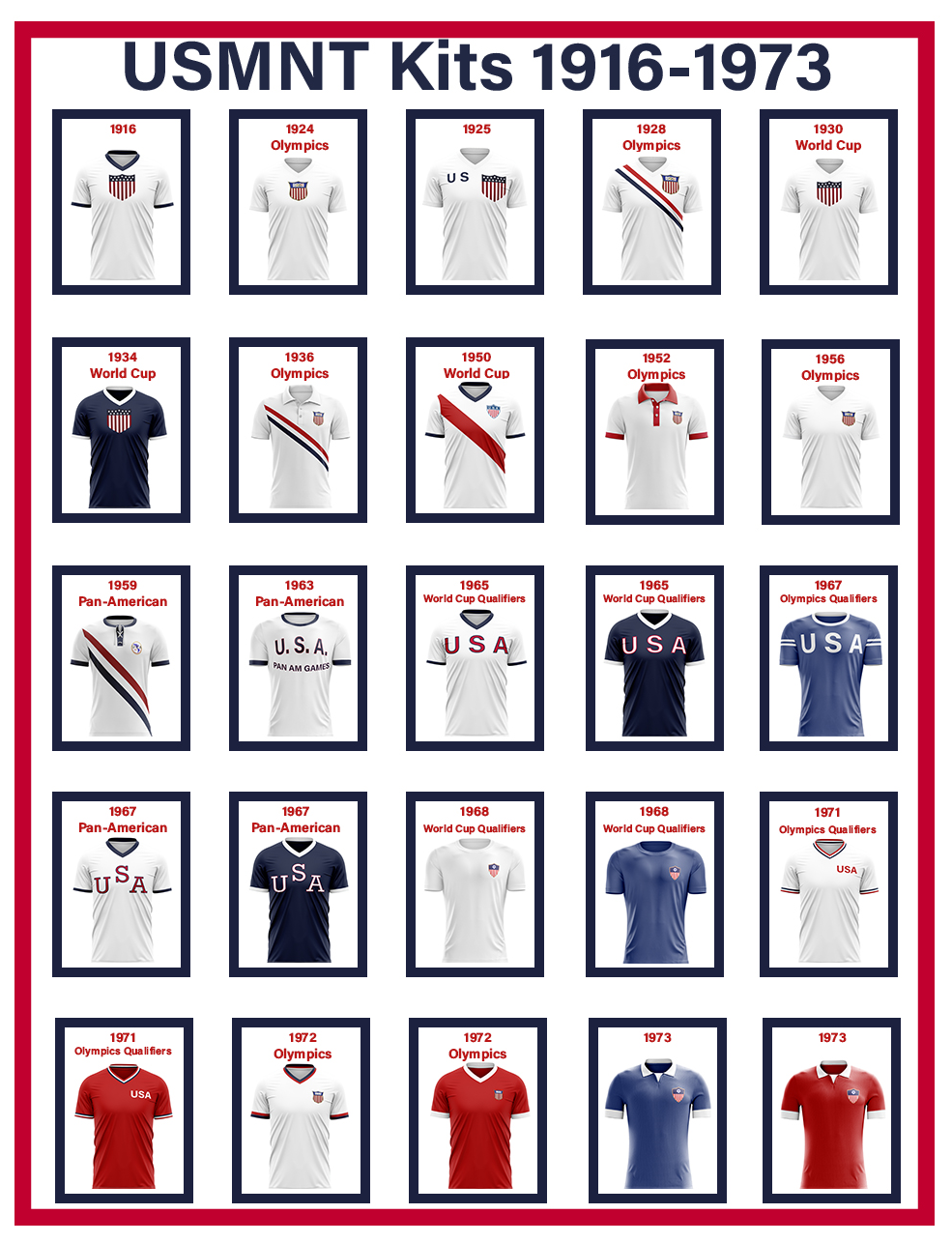
USMNT Kits – 1974-1983
The group of kits for the USMNT were the first that were sponsored by Adidas. There were a lot of similar styles of kits during this time which really lacked any creativity. My favorite kits in the group are the ones from the middle to late 1970s, there is something about their simplicity and clean look.
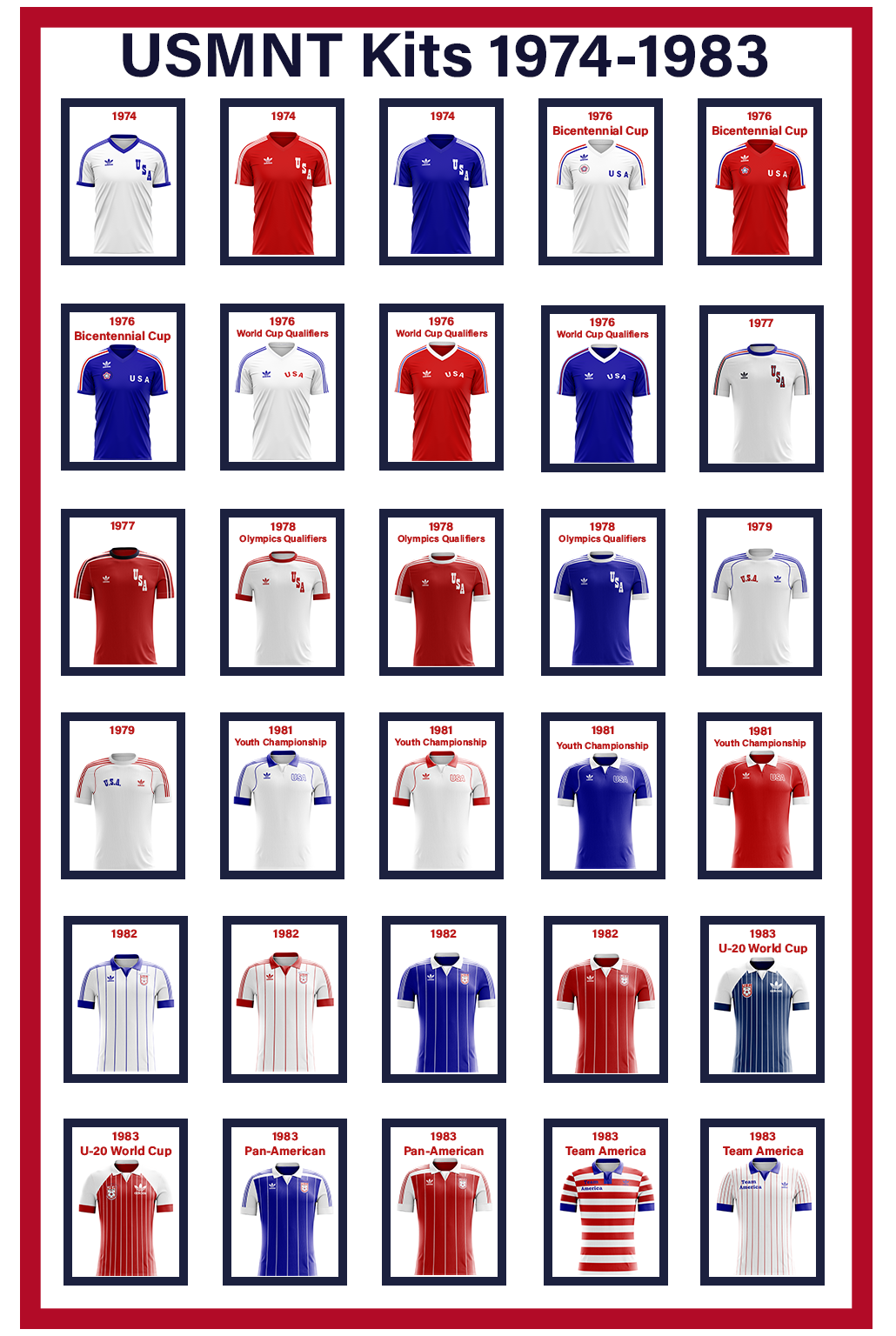
USMNT Kits – 1984-1994
Adidas’s 20-year run of creating kits for US Soccer ended in 1994, with few quality kits made during those couple of decades, which is ironic considering how nice Adidas’s kits are today. My favorite kits in the group are the 1985/1986 blue hoop kit and the 1988 Blue Olympic kit.
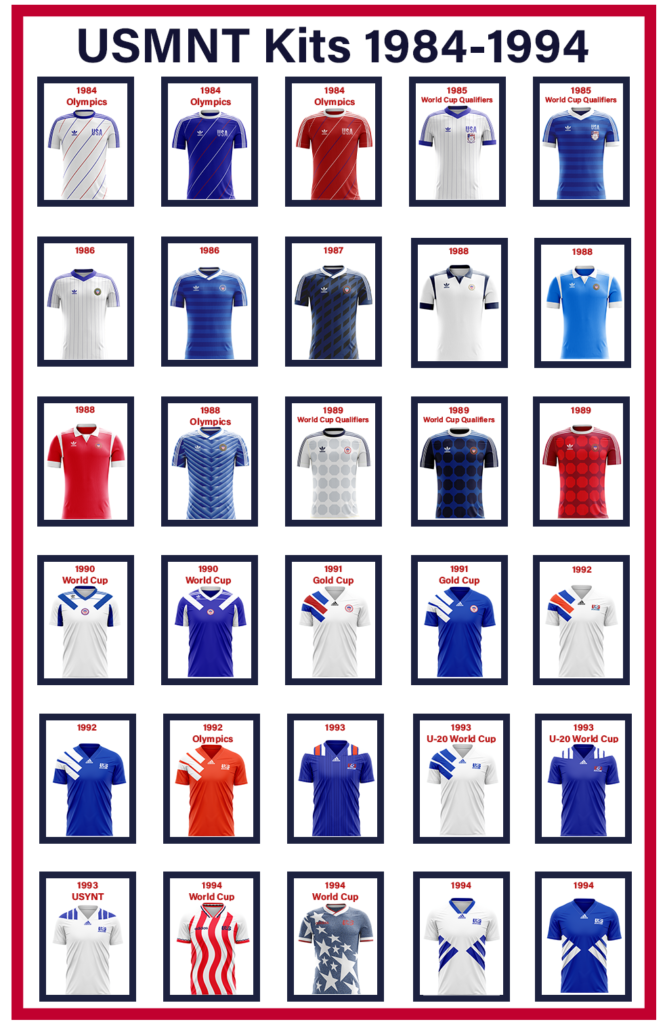
USMNT Kits – 1995-2011
In 1995 Nike took over the creation of the US Soccer kits and started by making three similar kits for the 1995 Copa America and 1996 third kit for the US Cup. Nike did release three Special Edition kits in 2003, 2004, and 2006, which were only worn for one match each. My favorite kits in the group all had a sash on them, which were both the 2010 World Cup kits and the red 2011 Gold Cup kit.
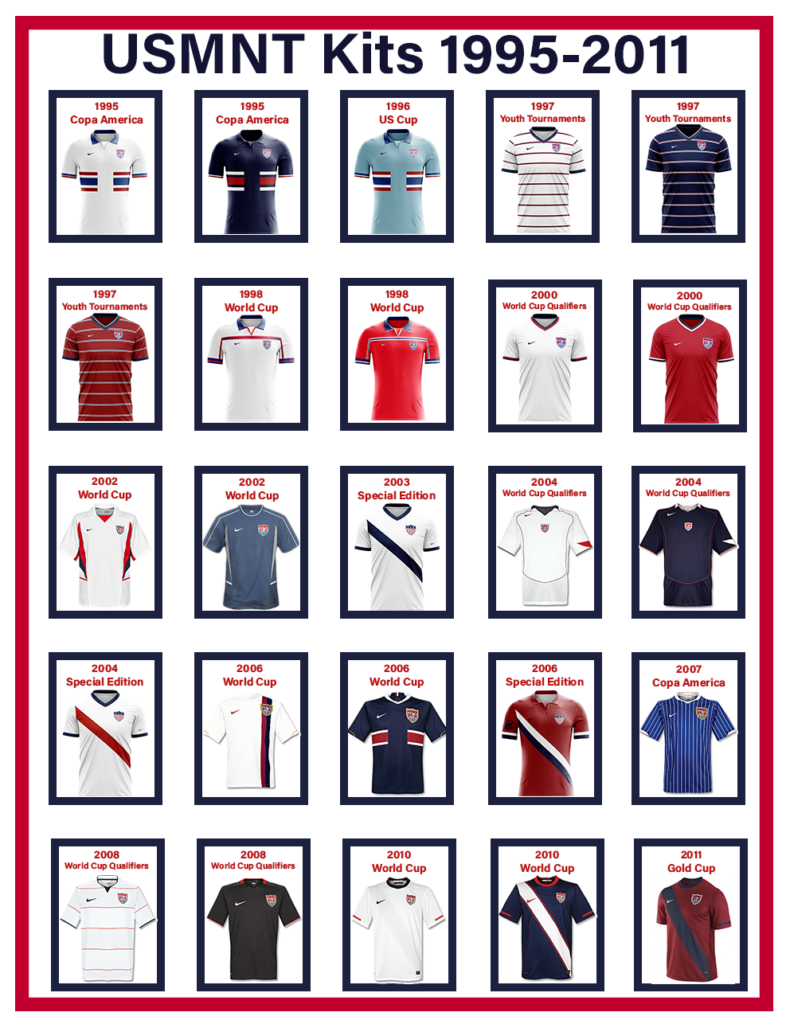
USMNT Kits – 2012-Current
Most USMNT fans would agree that recent kits released by Nike haven’t held the standard seen in the 2010s, where the hoops/stripes that some many fans loved for the 2012 Waldo kits were incorporated. My unsung kits of this group are the 2018 home kit, which would have been worn at the 2018 FIFA World Cup, and the 2017 Gold Cup kit.
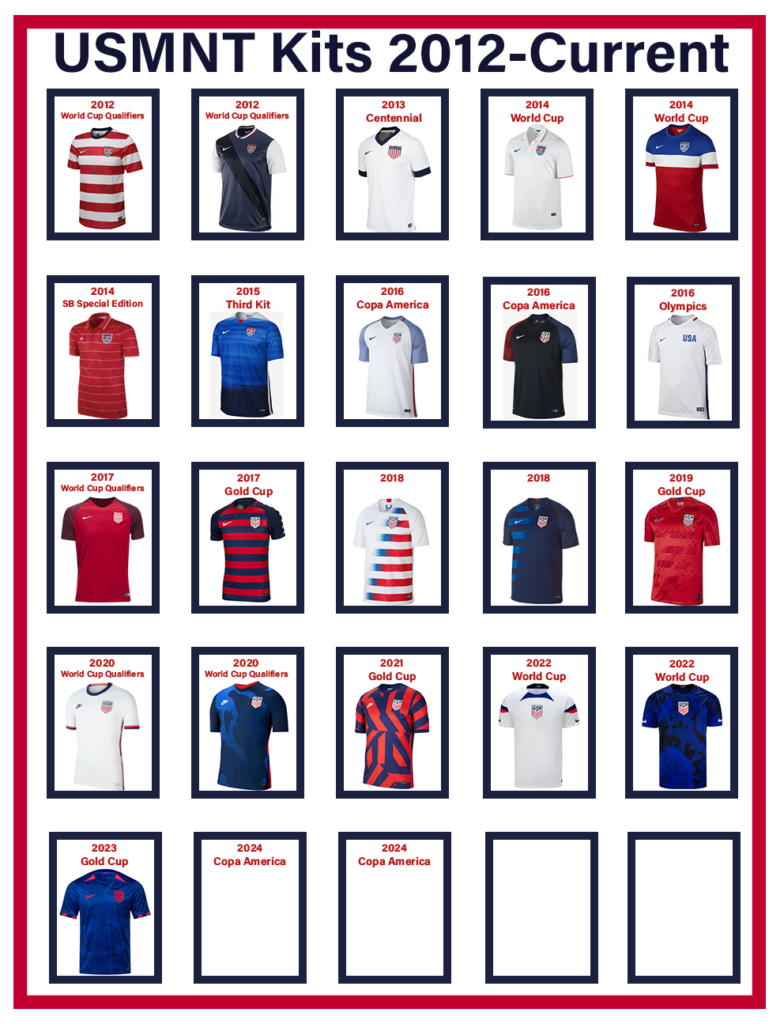
USMNT Kits going forward
Nike and US Soccer signed what was considered a historical long-term sponsor agreement, in November 2021, that went into effect in Janaury 2023 that will run for at least a decade which will cover the 2026 FIFA World Cup and 2028 Summer Olympics and possibly a 2027 or 2031 Women’s World Cup hosted in the United States, so for fans who has hoped for a different kit creator they will have to wait a while.
Once the 2024 Copa America kits are released US Soccer will likely only release one more kit for the 2025 Gold Cup for the USMNT before releasing the 2026 World Cup kits. One idea that I’ve had for a long time was for US Soccer to release Special Edition Kits with styles from the past, with the limited release of those kits, coupled with playing matches in locations and venues throughout the United States to build the fan base and excitement for the 2026 FIFA World Cup.
In conclusion, I am somewhat optimistic that US Soccer and Nike will create some variation of the 2012 Waldo kit & 1994 Stats and Denim kit to be worn as the hosts of the 2026 World Cup.
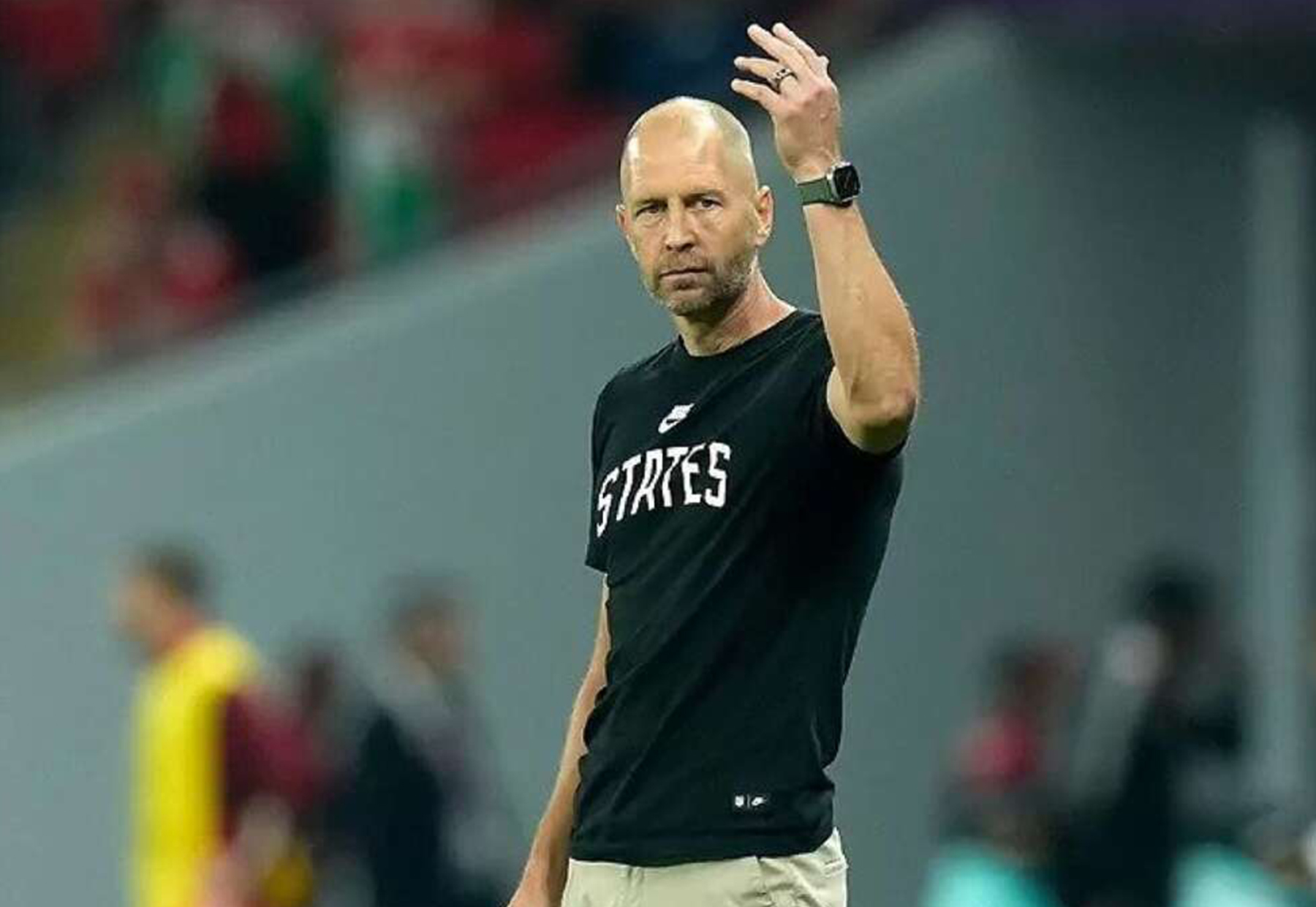
Thomas Deschaine (@uskeeper on X/Formally Twitter)
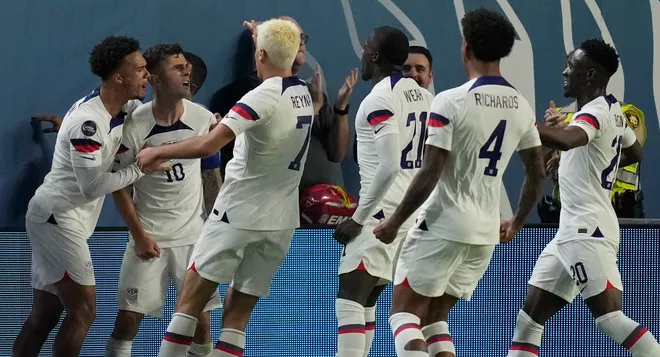
Photo From: USA Today-John Locher, AP – 18, June 2023 – 2023 Concacaf Nations League
As the fog hovered over Estadio Parque Artigas Stadium in Paysandú, Uruguay in the 58th minute Eric Wynalda received the ball on the right wing with Joe-Max Moore making a run forward and in front of Wynalda who delivered a pass to Moore who then went down preventing the ball from being taken away and sending it back to Wynalda who slides forward and scores the third goal of the match and his third goal of the tournament, making it 3-0 USA over tenth-ranked Argentinians and all but sealing the win and the top spot in Group C at the 1995 Copa America. The win for this USMNT consisted of 17 players from the 1994 World Cup team who reached their pinnacle with this group of players finishing fourth at this Copa America.
Over the previous three decades, the USMNT has had some of the biggest wins in the team’s history. During the 1999 Confederations Cup, which was played in Mexico the USMNT played a hard-fought match against the fifth-ranked Germans defeating them 2-0 in the final group stage match and finishing third overall in the tournament. The USMNT would also have an even bigger result against second-ranked Spain in the semi-finals of the 2009 Confederations Cup when they ended Spain’s 35-game unbeaten streak in a 2-0 victory that would send them to the final against Brazil.
2024 is the midway point of the 2026 FIFA World Cup cycle, and the next two windows for the USMNT who as a team and federation need to start ascending to their apex with this group to ensure that they have an amazing performance at the 2026 World Cup.
The USMNT has already played their first match, a 1-0 defeat to Slovenia, but need to quickly focus on the March window 2024 CONCACAF Nations League Finals where they will play Jamaica in the semi-final round and a win would put the USMNT in their third straight Nations League Final where they would have a chance to play either Mexico or Panama and win their third straight Concacaf Nations League trophy.
Some 90 days later the USMNT will be kicking off only their fifth appearance at the Copa America Tournament, with the stakes for this group at an all-time high and where success is demanded from the players, coaches, fans, and the federation. Will this current group of USMNT players and coaches be able to progress to the next level against the elite teams of CONMEBOL? It’s worth noting that the USMNT has finished fourth twice at Copa America in 1995 and 2016, however, the USMNT finished 32nd at the 1998 World Cup and failed to qualify for the 2018 World Cup.
The U-23 USMNT will also be playing the Olympics for the first time since 2008, which provides a great opportunity for those U-23 players to get noticed on a big stage. There are many eligible players who if released by their clubs will have a great opportunity to impress while helping the U-23 USMNT make a deep run at the 2024 Olympics in France.
As it becomes increasingly harder for the USMNT to schedule non-Concacaf opponents the US Soccer Federation will need to get creative in who and where they schedule these Friendly matches. The June window offers up the best opportunities for the USMNT to schedule matches against other CONMEBOL teams, preferably in Groups A and B which feature Argentina, Chile, Ecuador, Peru, and Venezuela.
Edgar Moreno on X, formally Twitter, reported that the USMNT and Colombia have scheduled a Friendly headed into Copa America. It was also reported on Goal.com that Colombia will be scheduling a total of four matches leading into the tournament, two of which will be taking place in Europe. While there are challenges with timing and logistics around scheduling Friendlies with UEFA teams, USSF really needs to do everything possible to secure a similar type of schedule headed into Copa America but, rarely schedules USMNT Friendlies outside of the FIFA International window, which Colombia would need to do to make that schedule work.
It has been recently rumored that the USMNT might close to scheduling a Friendly with Colombia headed into Copa America. The September and October windows have few quality opponents available, at the time of the article it appears that the September window could be an opportunity to play schedule matches with teams from the CAF Confederation, but those matches would likely need to be played at neutral sites in Europe.
2024 USMNT Window
| March | June Window | Copa America | September | October | November |
| CNL Finals March 18-26 | Friendlies June 3-11 | June 20-July 14 | Friendlies Sept. 2-10 | Friendlies Oct. 7-15 | CNL quarterfinals Nov. 11-19 |
Below are eight years since the 1994 cycle that at the time were considered big years for the USMNT as they were playing in FIFA tournaments against teams from other confederations. Below is a look at how they fared.
1992
6 Wins, 4 Draws, 11 Losses, GF-21, GA-27
Third Place at the King Fahd Cup renamed Confederations Cup in 1997 edition.
First at U.S. Cup (Participating teams –Ireland, Italy & Portugal)
Top Goal Scorers
5-Eric Wynalda
3-Hugo Perez
3-Marcelo Balboa
2-Bruce Murray
2-John Harkes
Goalkeeper Stats
5 Wins – Tony Meola
4 Shutouts – Tony Meola
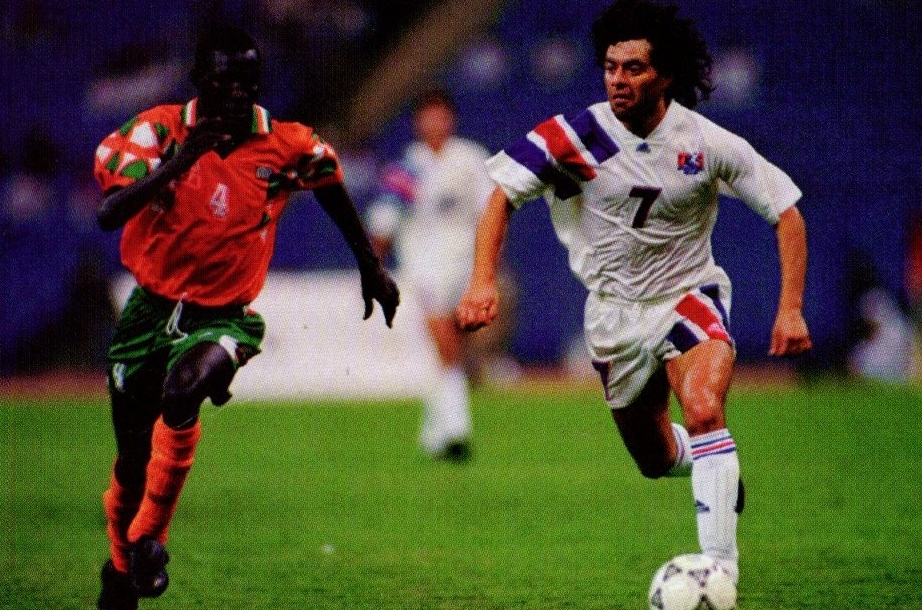
Photo From: Soccer International, Volume 3, Issue 12, December 1992
1993
10 Wins, 11 Draws, 13 Losses, GF-45, GA-44
Twelfth place at Copa America
Second Place at Gold Cup
Third Place at U.S. Cup (Participating teams – Brazil, England & Germany)
34 matches played 1st All-Time
11 Draws tied for 1st All-Time with 1994
13 Loses 1st All-Time
44 Goals Conceded 1st All-Time
Top Goal Scorers
8-Joe-Max Moore
7-Dominic Kinnear
4-Alexi Lalas
4-Thomas Dooley
Goalkeeper Stats
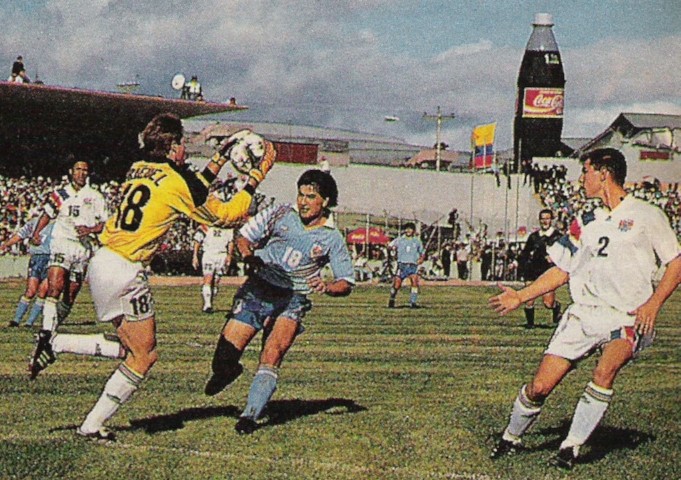
Photo From: El Grafico Number 3847, June 16, 1993
7 Wins – Tony Meola
8 Shutouts – Tony Meola
1995
5 Wins, 3 Draws, 6 Losses, GF-20, GA-18
Fourth Place at Copa America
First at U.S. Cup (Participating teams – Colombia, Mexico & Nigeria)
Top Goal Scorers
3-Eric Wynalda
2-Joe-Max Moore
2-Alexi Lalas
2-John Harkes
Goalkeeper Stats
3 Wins – Kasey Keller
2 Shutouts – Brad Friedel & Kasey Keller
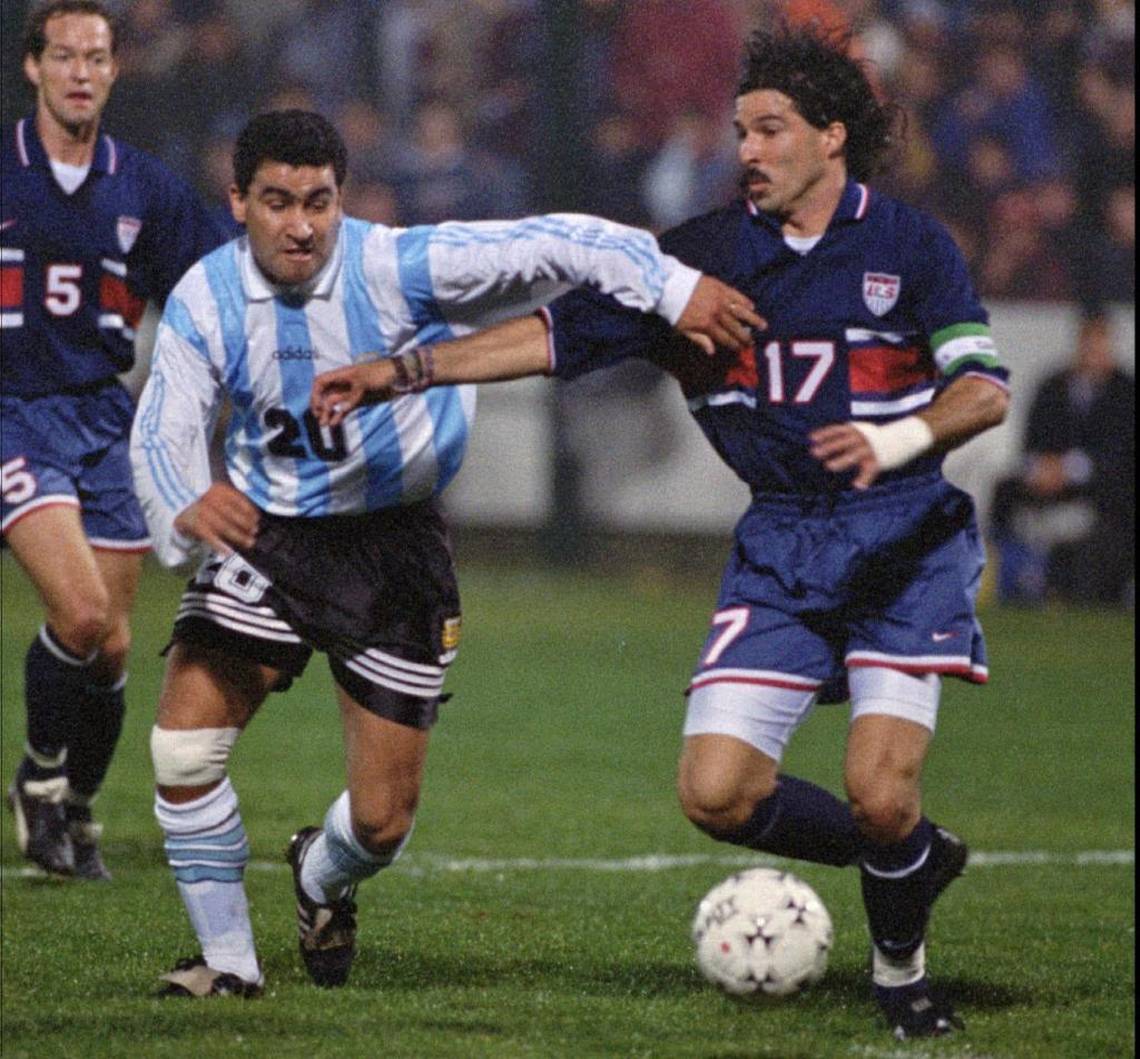
Photo From: DIEGO GIUDICE Associated Press file, July 14, 1995
1999
7 Wins, 2 Draws, 4 Losses, GF-19, GA-11
Third Place at Confederations Cup
Second Place at U.S. Cup (Participating teams – Bolivia, Guatemala & Mexico)
Top Goal Scorers
3-Joe-Max Moore
3-Brian McBride
2-Ben Olsen
2-Jovan Kirovski
2-Frankie Hedjuk
Goalkeeper Stats
2 Wins – Brad Friedel & Kasey Keller
2 Shutouts – Brad Friedel & Tony Meola
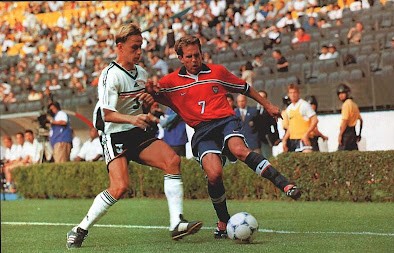
Photo From: FIFA Report- 1999 Mexico, July 30, 1999
2003
10 Wins, 2 Draws, 4 Losses, GF-28, GA-10
Seventh Place at Confederations Cup
Third place at Gold Cup
Top Goal Scorers
7-Landon Donovan
4-Carlos Bocanegra
3-Brian McBride
3-Chris Klein
Goalkeeper Stats
6 Wins – Kasey Keller
5 Shutouts – Kasey Keller
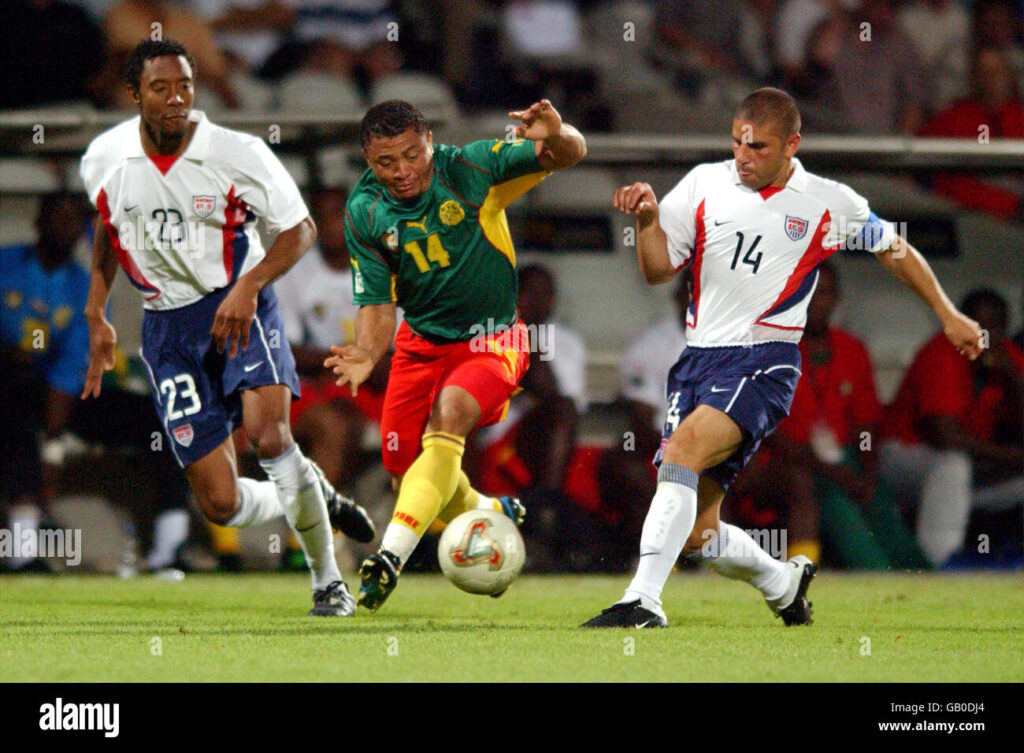
Photo From: FIFA Confederations Cup, June 23, 2003
2007
12 Wins, 1 Draws, 5 Losses, GF-31, GA-19
Twelfth Place at Copa America
First Place at Gold Cup
Top Goal Scorers
9-Landon Donovan
3-Clint Dempsey
3- DaMarcus Beasley
2-Eddie Johnson
2-Benny Feilhaber
2-Carlos Bocanegra
Goalkeeper Stats
8 Wins – Tim Howard
4 Shutouts – Tim Howard
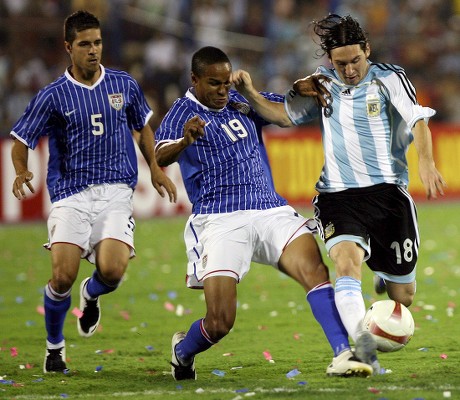
Photo From: Guillermo Legaria – FIFA Copa America, June 28, 2007
2009
13 Wins. 3 Draws, 8 Losses, GF-43, GA-36
Second Place at Confederations Cup
Second Place at Gold Cup
Top Goal Scorers
6-Jozy Altidore
5-Landon Donovan
4-Clint Dempsey
4-Michael Bradley
3- Sacha Kljestan
3- Charlie Davies
Goalkeeper Stats
7 Wins – Tim Howard
4 Shutouts – Tim Howard
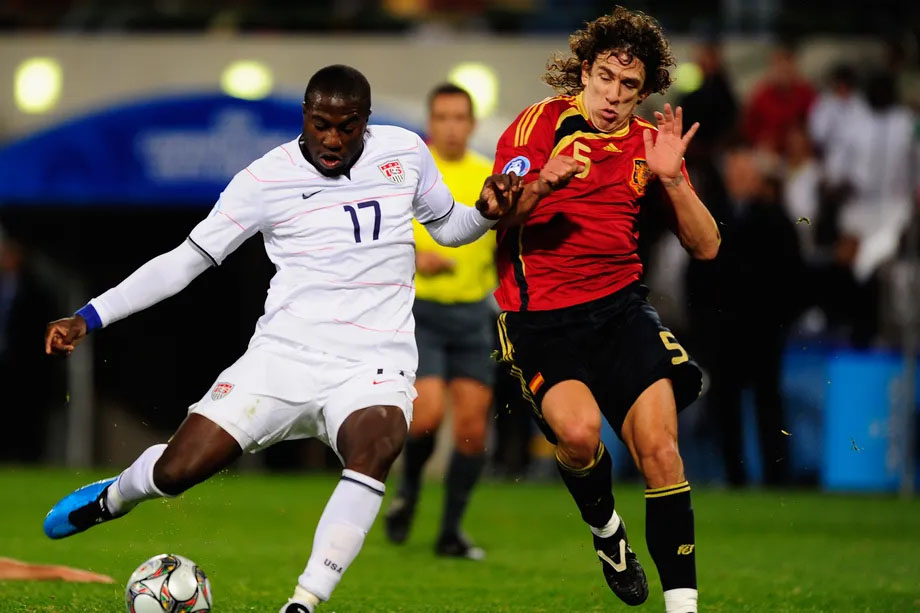
Photo From: Jamie McDonald/Getty Images
2016
12 Wins, 1 Draw, 6 Losses, GF-37, GA-20
Fourth Place at Copa America
Top Goal Scorers
6-Jozy Altidore
4-Bobby Wood
4-Clint Dempsey
3-Christian Pulisic
3-Gyasi Zardes
Goalkeeper Stats
8 Wins – Brad Guzan
6 Shutouts – Brad Guzan
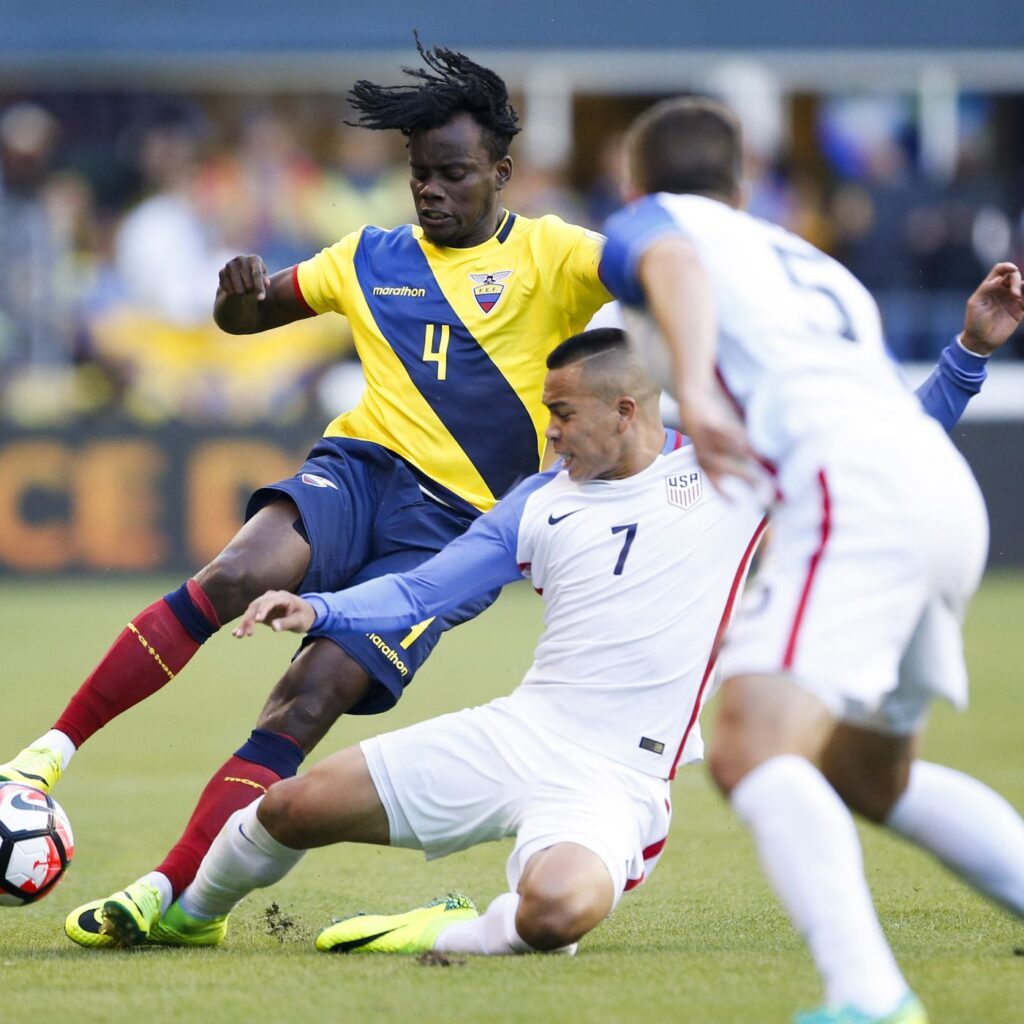
Photo From: Jennifer Buchanan-USA TODAY Sports
Expectations for the in 2024 USMNT
The USMNT is expected to once again advance to the Nations League Final and with their full fit A Squad should be able to bring home their third Nations League trophy, but the 2024 Copa America tournament is very possible the most important non-World Cup the USMNT has even competed it. How success and failure will be determined by the USSF and fans will be interesting to follow. Gregg Berhalter has to prove that he can put together a roster, a formation that allows for simple and effective tactics that will allow the USMNT to not only compete against some top-tier nations but beat them. Success for me isn’t just advancing to the semi-finals of Copa America The USMNT needs to perform at the next level against the top-tier nations, something that I’ve only seen a handful of times in my nearly 35 years as a USMNT fan.
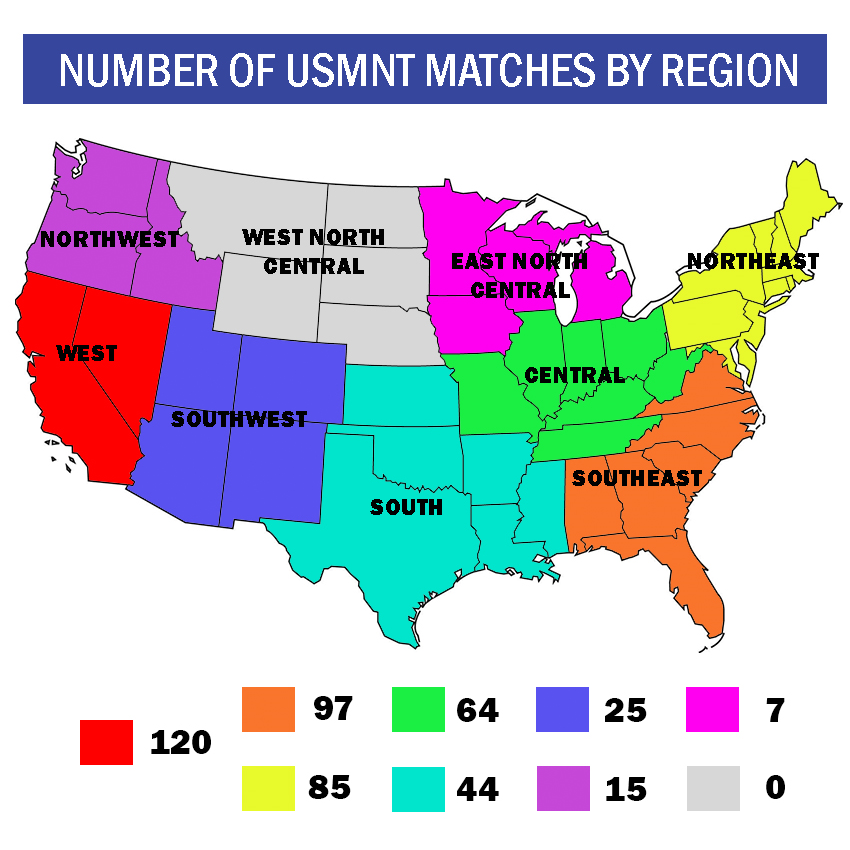
Where the USMNT Should Play Next and Why?
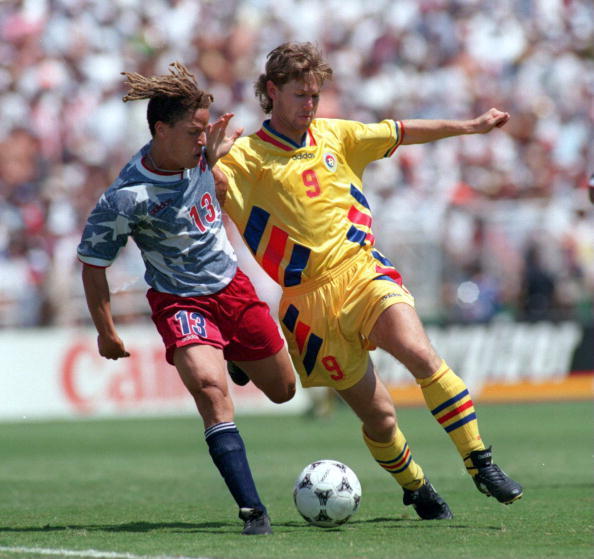
The largest USMNT home attendance of 93,869 took place at the 1994 World Cup in a 1-0 loss to Romania at the Rose Bowl in Pasadena, California.
The U.S. men’s national team announced last month that their only January Camp 2024 Friendly match would be played in the nearly 8,300-seat Toyota Field, home of the USL Championship team San Antonio FC. This marks only the third time USMNT has played a match in a USL venue, the last match was in March 2018, at WakeMed Soccer Park, in Cary, North Carolina. It also marked the 16th time that the USMNT will be playing a match at a venue with a capacity of less than 10,000 (USMNT have played 13 matches at 10,000 seat capacity).
How and where USMNT decides to play matches has recently been scrutinized by fans who live in areas of the United States where matches are rarely — or never — played. Back in March 2023, the USMNT played their final Concacaf Nations League match in Orlando, making its sixth appearance in Orlando since Exploria Stadium opened in 2017. The USMNT has also played seven matches in the state of Ohio since the beginning of the 2018 cycle, four of which have been played in Cincinnati, which is tied for the second most matches played in a city since 2018. USMNT fans nationwide who haven’t been able to attend a local or regional match recently continue to ask why the same handful of venues continue to be selected, even for Friendly matches.
Since the beginning of the 2018 cycle, the USMNT has played 62 home matches at 28 venues, but 10 of those venues have hosted three or more times. The USSF doesn’t have control over which venues the USMNT will play their Gold Cup and Nation League Finals matches, but it does with friendlies, World Cup Qualifiers, and all home Nations League matches.
During the Gregg Berhalter era (yes, I am counting the six-ish months when Anthony Hudson and B.J. Callaghan coached) the USMNT played the second- and third-longest consecutive home match stretches; 15 consecutive home matches in 2019 and 14 consecutive home matches in 2023. Both were years when the Gold Cup was played. The longest stretch was in 1994 when the USMNT hosted the World Cup and played 17 consecutive home matches. As we look forward to 2024 it is possible that the USMNT could reach 16 consecutive home matches played if they can play the maximum amount of Copa America matches and don’t schedule any road or neutral location matches during the September and October windows.
When posting on X (formerly Twitter) about the match at Geodis Park in Nashville, Tennessee, the USMNT account said, “Another stadium to cross off the list,” which appears to be a jab at the USMNT fans about venue selection. The recently scheduled January Camp match scheduled in San Antonio isn’t the first time the USMNT has played in this city. They beat Costa Rica 1-0 in 1988 at Alamo Stadium and in 2015 beat Mexico 2-0 at the Alamodome.
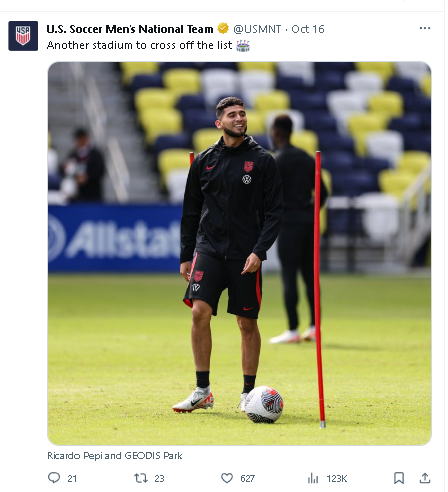
Breaking Down Recent USMNT Home Matches
Below are the US Cities in which the USMNT has played since the beginning of the 2018 cycle up through the group stage matches of Copa America 2024.
| Kansas City, Kansas* | 5 |
| Orlando, Florida | 5 |
| Arlington, Texas | 4 |
| Austin, Texas | 4 |
| Cincinnati, Ohio | 4 |
| Nashville, Tennessee | 4 |
| Carson, California | 3 |
| Paradise, Nevada | 3 |
| St. Louis, Missouri | 3 |
| St. Paul, Minnesota | 3 |
Below are the US States in which the USMNT has played since the beginning of the 2018 cycle through the Copa America 2024 group matches.
| Texas | 10 |
| Florida | 7 |
| Ohio | 7 |
| California | 6 |
| Kansas* | 5 |
| Missouri | 4 |
| Tennessee | 4 |
*All three 2021 Gold Cup Group Stage matches were played at the same location.
In the past, locations and venue selection for World Cup qualifiers haven’t been ideal to ensure a true home-field advantage for the USMNT (see the 2018 World Cup qualifier against Costa Rica played at Red Bull Arena in Harrison, New Jersey). The US Soccer Federation has started to rely on the same 7 or 8 venues for critical matches. But, with the USMNT not needing to qualify for the 2026 FIFA World Cup, USSF has a great opportunity to play in locations they have never played before, or at least in recent memory.
As it currently stands, the USMNT hasn’t played a match in 22 of the 50 states (plus the District of Columbia) and there are seven states in which the USMNT hasn’t played a match in nearly 10 years. Indiana, South Carolina, Louisiana, and Kentucky are the four most populated states to never host a USMNT match, and very much overdue to get matches scheduled at those locations.
One of the seven locations that haven’t seen the USMNT play in over 10 years is Michigan, which has seen two of the largest crowds to watch International Club soccer, the largest attendance of 109,318 in 2014 when Manchester United defeated Real Madrid 3-1 and the 2nd largest attendance of 105,826 in 2016 saw Real Madrid defeat Chelsea 3-2 both were played at the University of Michigan Stadium aka “The Big House”.
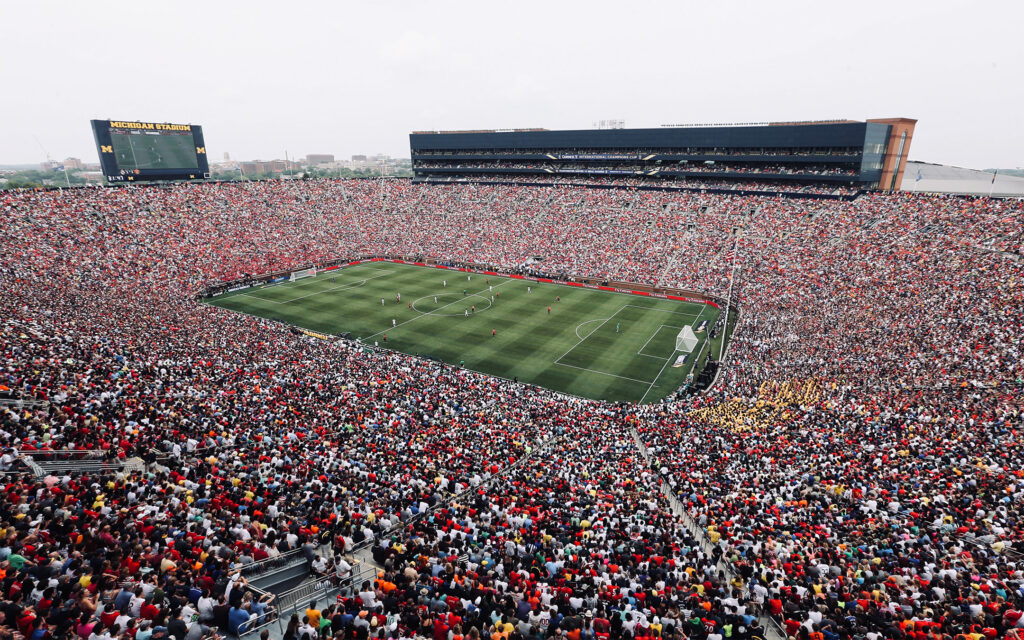
Which State or Venue Should the USMNT Play at Next?
Here’s a look at 10 locations/venues where I would like to see the USMNT play over the next couple of cycles. There are some challenges in getting matches scheduled in certain states and venues due to the playing surface not being grass or the venue not being the required size, which is the case in many of the NCAA football fields.
The below graphic shows the regions where the USMNT has played or already scheduled 457 home matches, up through the Copa America 2024 group stage.

Alabama
Protective Stadium – Birmingham, Alabama
Birmingham Legion FC – USL Championship & UAB Blazers – NCAA Football
Capacity – 47,100
Under the management of Bruce Arena, the USMNT played three matches in Alabama during the 2002 and 2006 cycles, but haven’t returned in almost 18 years.
Last three Matches played in Alabama
March 30, 2005 – 2-0 win vs Guatemala – Birmingham, Alabama – Legion Field – World Cup Qualifier
March 10, 2002 – 1-0 win vs Ecuador – Birmingham, Alabama – Legion Field – Friendly
March 12, 2000 – 1-1 draw vs Tunisia – Birmingham, Alabama – Legion Field – Friendly
Arkansas
War Memorial Stadium – Little Rock, Arkansas
Little Rock Rangers – USL2 & Secondary Home of Arkansas Razorbacks – NCAA Football
Capacity – 54,120
Neither the US Men’s nor Women’s National teams have played a soccer match in the state of Arkansas. Another option could be to play at the recently announced expansion USL Championship team to be located in Northwest Arkansas.
Last three Matches played in Arkansas
No matches played
Hawaii
New Aloha Stadium (2033 – 2038) – Honolulu, Hawaii
University of Hawaii – NCAA Football
Capacity – Expected 25,000 – 30,000
With a new Aloha Stadium expected to be built and hopefully finished in the next 10 years, playing a match in Hawaii seems more likely an option for the USMNT in the future, the perfect opportunity for a January camp location.
Back in 2015, the USWNT had a scheduled victory tour match at the current Aloha Stadium but was canceled on the day of the match because the artificial turf surface at the stadium was deemed unplayable.
Last three Matches played in Hawaii
No matches played
Idaho
Albertsons Stadium – Boise, Idaho
Boise State University – NCAA Football
Capacity – 36,387
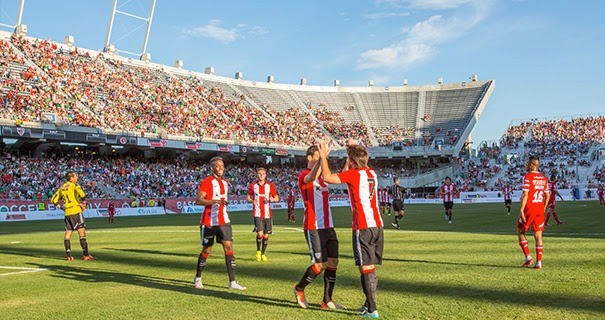
Neither the USMNT nor the USWNT has ever played a match in Idaho, or any of the other surrounding states of Montana, North Dakota, and South Dakota. However, in 2015 a friendly match was scheduled at the home of Boise State University at Albertsons Stadium, which is known for its blue surface, aka “Smurf Turf.” The Basque Soccer Friendly featured Athletic Bilbao of La Liga against Club Tijuana of Liga MX in front of a crowd of 21,948 with Athletic Bilbao winning 2–0.
Last three Matches played in Idaho
No matches played
Indiana
Future – Indy Eleven Stadium – Indianapolis, Indiana
Indy Eleven – USL Championship
Capacity – 20,000
The senior USMNT has never played in the state of Indiana. The B Team, however, has played Olympic qualifying matches there for the 1988 and 1992 Olympics, as well as the 1987 Pan American Games, with games not counting as full international caps
Last three Matches played in Indiana
May 10, 1992 – 3-1 win vs Canada – Bloomington, Indiana – Bill Armstrong Stadium – Olympic Qualifying
August 15, 1987 – 0-2 loss vs Argentina – Indianapolis, IN – Kuntz Memorial Soccer Stadium- Pan American Games
May 25, 1987 – 4-1 win vs El Salvador – Indianapolis, IN – Kuntz Memorial Soccer Stadium – Olympic Qualifying
Kentucky
Lynn Family Stadium – Louisville, Kentucky
Louisville City FC – USL Championship
Capacity – 11,700 (Expandable to 15,304)
Louisville City FC has been one of the more successful and popular USL teams in recent seasons and has an amazing fan base. This spurred the building of their soccer stadium in 2018. It is a logical location for a USMNT match.
Last three Matches played in Kentucky
No matches played
New York City
Future – New York City FC – Bronx, New York
New York City FC – MLS Team
Capacity – 25,000

The US Men’s National Team hasn’t played in the New York City area in nearly 40 years, even though they have played matches at the home stadium of the New York Red Bulls which is in New Jersey.
Last three Matches played in New York City Area
November 30, 1984 – 0-0 draw vs Ecuador – Hempstead, New York – Hofstra Stadium– Friendly
September 15, 1968 – 3-3 draw vs Israel – Bronx, New York – Yankee Stadium – Friendly
May 27, 1964 – 0-10 loss vs England – Randall’s Island, New York – Downing Stadium – Friendly
New York (Upstate)
Future – Buffalo Bills stadium (2026) – Orchard Park, New York
Buffalo Bills – NFL Team
Capacity – 62,000
The US Men’s National Team has never played in Upstate New York and with the new stadium being built for the Buffalo Bills — expected to be finished sometime in 2026 — the area would have a good venue for the USMNT to play.
Last three Matches played in Update New York
No matches played
New Mexico
Proposed – New Mexico United Stadium – Albuquerque, New Mexico
New Mexico United – USL Championship
Capacity – 12,000
Another stadium option for the USMNT in New Mexico would be University Stadium also in Albuquerque, which had a seating capacity of over 30,000, however the overall attendance in the only three matches played there wasn’t impressive.
Last three Matches played in New Mexico
March 19, 2005 – 1-0 win vs Honduras – Albuquerque, New Mexico – University Stadium – Friendly
April 30, 1994 – 0-2 loss vs Chile – Albuquerque, New Mexico – University Stadium – Friendly
June 7, 1988 – 0-1 loss vs Ecuador – Albuquerque, New Mexico – University Stadium – Friendly (Clasico International Cup)
Oregon
Providence Park – Portland Oregon
Portland Timbers – MLS
Capacity – 25,218

It’s been 10 years since the USMNT has played in Oregon and with the Pacific Northwest being a soccer-crazed region, is time for the USMNT to return, while the stadium is currently using field turf they would have to make the necessary accommodations to support a grass service.
Last three Matches played in Oregon
July 9, 2013 – 6-1 win vs Belize – Portland, Oregon – Jeld-Wen Field – Gold Cup-Group Stage
May 24, 1998 – 2-0 win vs Kuwait – Portland, Oregon – Civic Stadium – Friendly
September 7, 1997 – 1-0 win vs Costa Rica Portland, Oregon – Civic Stadium – World Cup Qualifier
Other venues and locations considered were Paladin Stadium at Furman University in South Carolina, Memphis 901 FC recently announced a new 10,000-seat stadium to be built in Memphis, Tennessee in the next several years, and Riccardo Silva Stadium home of the USL Championship team Miami FC. Louisiana is another state which has two venues, the Tad Gormley Stadium and the Superdome both of which the US Women’s National Team has played at in the past and could be suitable options for the USMNT in the future.
What are the next and necessary steps for the US Soccer Federation?
With so many high-profile soccer tournaments to be played in the United States over the next six years, this is a great opportunity for the USSF to expand its reach and bring the USMNT to places it’s never been. As it relates to attendance and ticket pricing, the USSF needs to figure out the formula that would allow for maximum capacity at all home matches while allowing for the federation to bring in the necessary revenue desired. Here’s hoping that the United States Soccer Federation sees it the same way and acts accordingly.
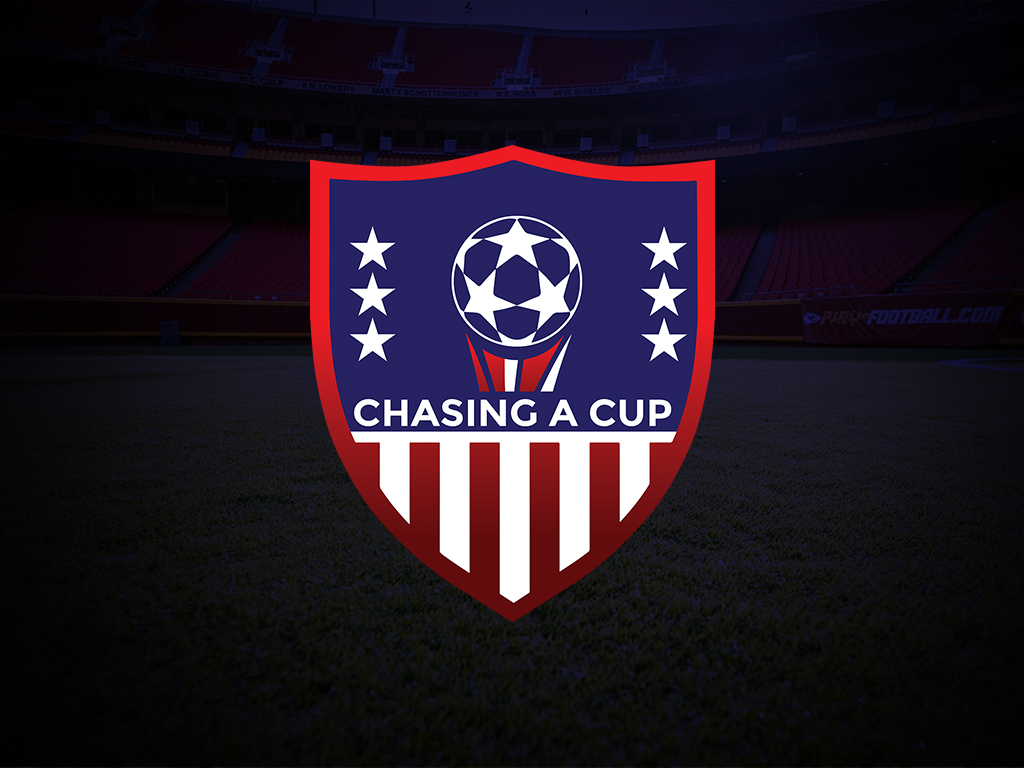

USMNT Kits Come in Different Styles and Colors

2024: A Pivotal Year for the USMNT

USMNT’S Next Great Location

Trending
-
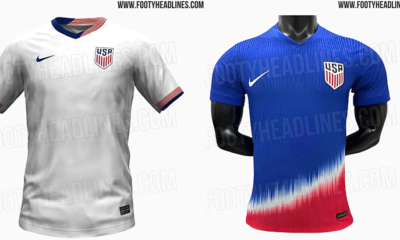
 USMNT1 month ago
USMNT1 month agoUSMNT Kits Come in Different Styles and Colors
-
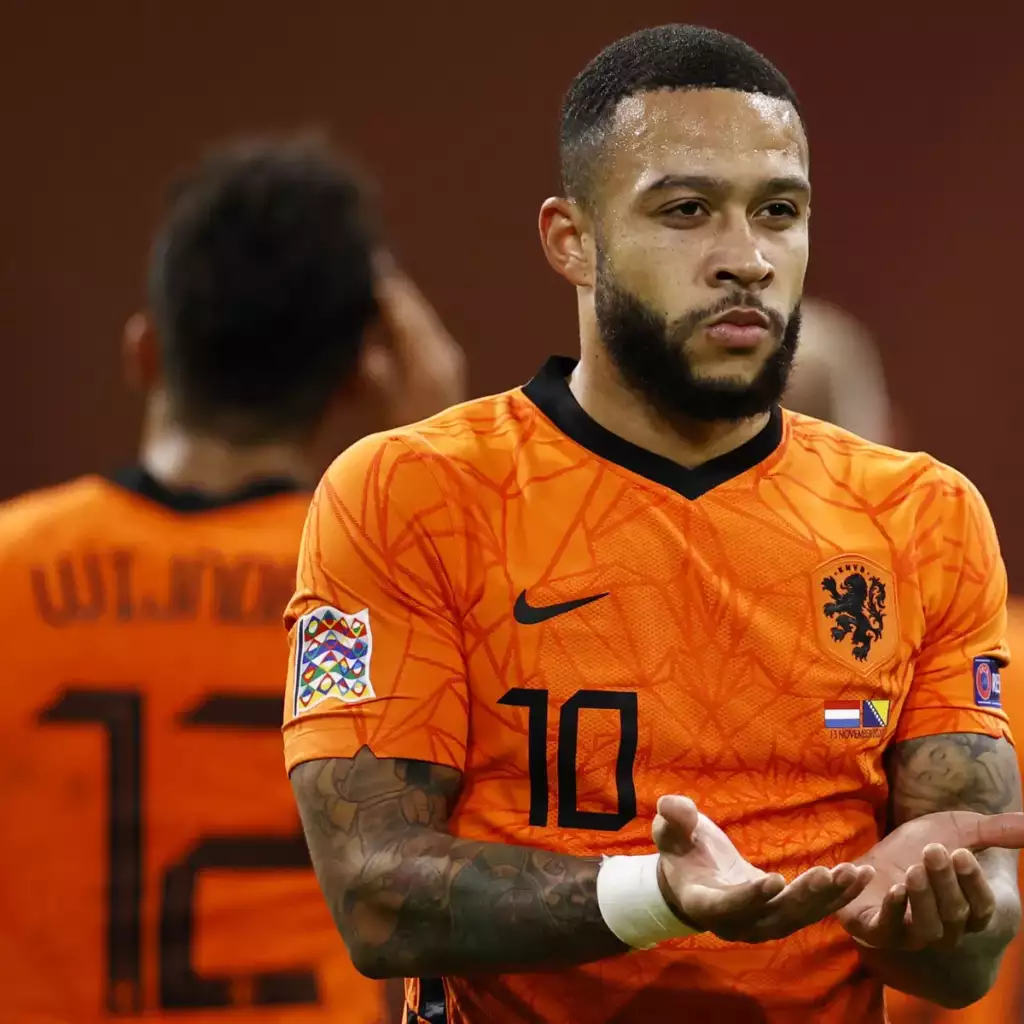
 USMNT1 year ago
USMNT1 year agoGROUPED OR GLORY: Group A
-
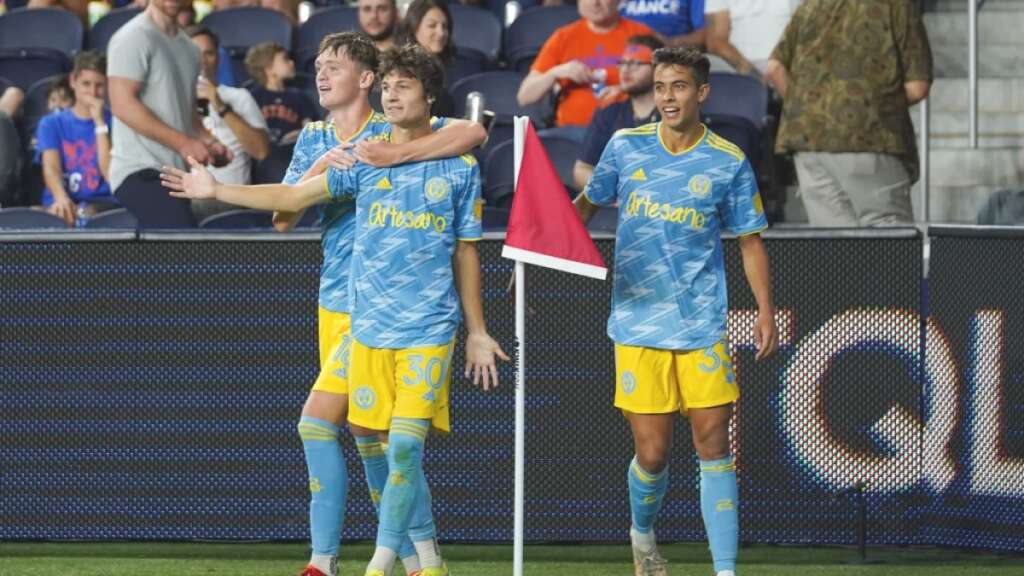
 MLS2 years ago
MLS2 years ago2022 Youth Series: MLS Club Youth Talent Rankings
-

 Club News4 years ago
Club News4 years agoJulian Vincente Araujo
-

 USMNT3 years ago
USMNT3 years agoA Hidden Gem: Barça Residency Academy
-
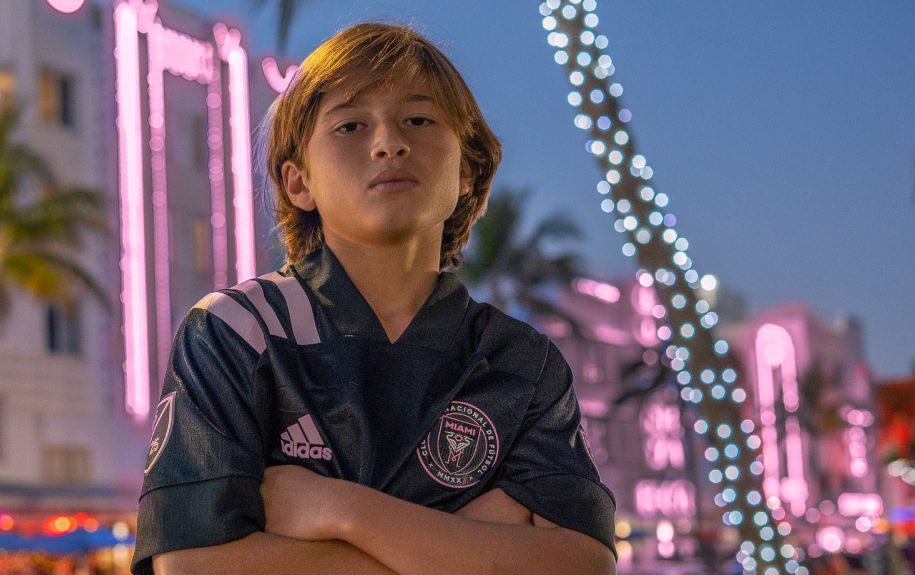
 Youth2 years ago
Youth2 years ago2022 Youth Series: Top 20 Born In 2007
-

 Club News4 years ago
Club News4 years agoRanking the top 50 American under 20 talents
-
USMNT4 years ago
MLS Quota

